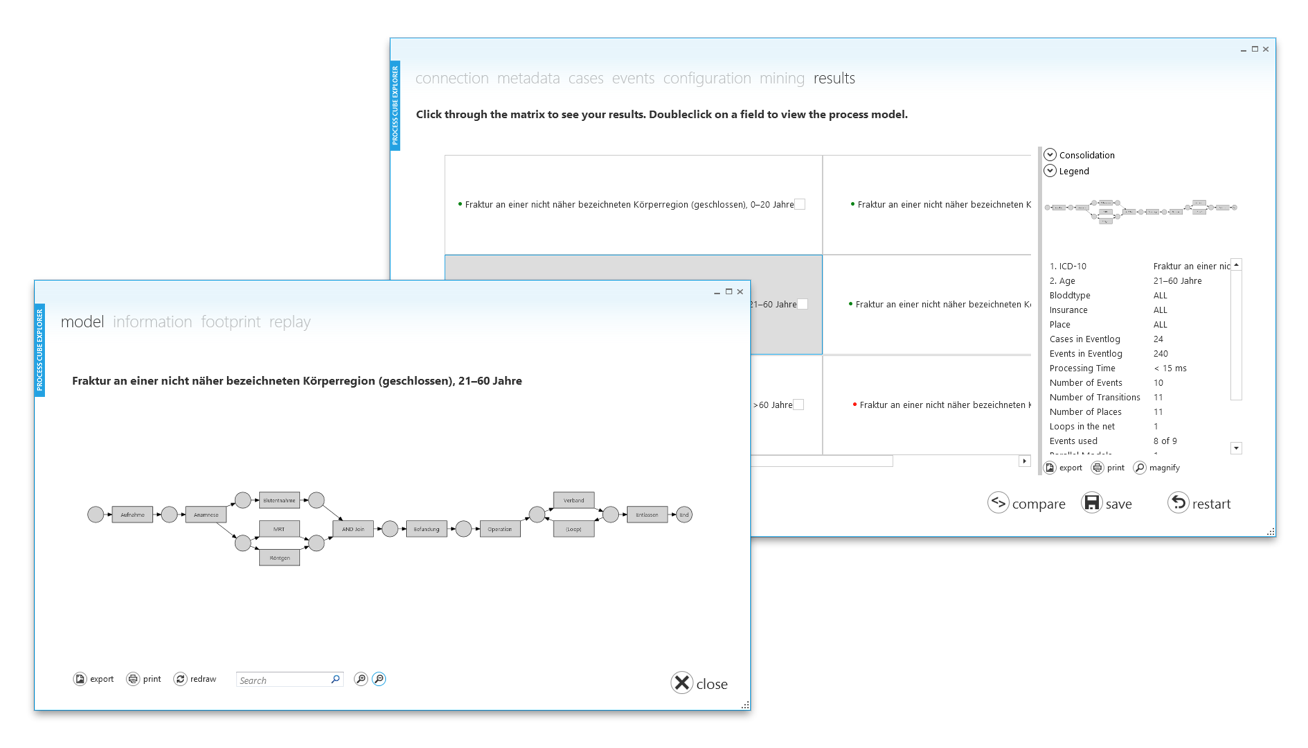Process Mining extracts implicit knowledge from event logs and generates process models to visualize the underlying process. The Process Cube Explorer can connect to various databases and load multidimensional event logs in which the characteristics of the process-instance are modelled as dimensions in a datawarehouse-like schema. See the documentation (in German) or example-database-script on how this works. You can then select dimensions and filters to create subsets of the event log to compare characteristics. This implementation also supports event-dimensions. As process discovery-algorithms we offer the Alpha Miner (and two extensions), the Heuristic Miner (in an improved twice-as-fast-implementation) and the Inductive Miner - infrequent. The results are petrinets that can be automatically compared, printed, exported, etc. You also have the chance to run two conformance checking-algorithms on them, the Comparing Footprints-Algorithm and a Token Replay.
The Process Cube Explorer was created by the Projektgruppe MPM at University of Oldenburg from april 2013 to march 2014. You can find it at https://github.com/pgmpm/ProcessCubeExplorer
Authors are: Jannik Arndt, Thomas Meents, Bernd Nottbeck, Moritz Eversmann, Andrej Albrecht, Bernhard Bruns, Krystian Zielonka, Christopher Licht, Naby Moussa Sow, Roman Bauer and Markus Holznagel (by percentage of authorship)
Copyright 2014 Projektgruppe MPM. All Rights Reserved.
Process Cube Explorer is free software: you can redistribute it and/or modify it under the terms of the GNU General Public License as published by the Free Software Foundation, either version 3 of the License, or (at your option) any later version.
Process Cube Explorer is distributed in the hope that it will be useful, but WITHOUT ANY WARRANTY; without even the implied warranty of MERCHANTABILITY or FITNESS FOR A PARTICULAR PURPOSE. See the GNU General Public License for more details.
You should have received a copy of the GNU General Public License along with Process Cube Explorer. If not, see http://www.gnu.org/licenses/.
This project also includes a slightly modified version of the open-source ModernUI-Framework by FirstFloor, hosted at https://mui.codeplex.com under MS-PL.
Have a look at our wiki for a step-by-step-tutorial!
You can just download our latest release and run the setup. The Process Cube Explorer will start automatically.
You can also download the source code, load the Process Cube Explorer.sln-Solution into Visual Studio and compile the code yourself. Notice that some unit-tests will fail if you don't enter credentials for a test-database (and we didn't want to publish ours).
The easiest way to try out the Process Cube Explorer is to set up a local MySQL-Server via Xampp and run the RunningExample.sql-script on it.
The software supports the following databases:
- Oracle
- MySQL
- MS-SQL
- PostgreSQL
- SQLite
Please note that you need to install the odac-drivers to use oracle-databases (http://www.oracle.com/technetwork/topics/dotnet/utilsoft-086879.html)
The example-data is (made up) clinical data, so you want to reduce it (either via dimension or filter) to one icd-10. Currently there are entries for T14.20 and T14.21.
You can choose one of the currently three mining-algorithms. These correspond (more or less) the the theoretical algorithms descriped in the documentation (in German) or here:
After the mining-step you should see a matrix with the results. You can double-click on any field to enlarge the process model, get more information or run the comparing-footprint-algorithm or the token replay.
The Process Cube Explorer was developed as a research-framework and is very easy to extend. Have a look at our wiki-page to get an overview of the architecture!
